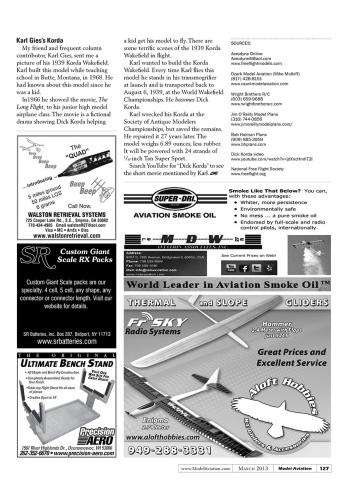“Millions long for immortality who do not know what to do with themselves on a rainy Sunday afternoon.”
—Susan Ertz (1894-1985)
Fortunately, few of us who enjoy FF stick-and-tissue modeling have that problem. We love rainy afternoons.
It’s the time to drag out that building board and create an object of flying art from some balsa, glue, wire, and tissue paper. After you have the frame built and ready to cover, start another model.
Delay covering the completed framework until a less-humid day! If you cover the model on a humid day, the tissue will shrink as the humidity drops and your piece of flying art might take on an “impressionistic” look.
Last year this column featured Frank Rowsome’s great-looking jumbo Messerschmitt Bf 109. He got it flying very well; well enough to fly away using only a 15% rubber motor after the DT failed at a contest last year. The flight, lasting more than six minutes, ended with the loss of the model in a thickly wooded area.
Scale model performance has improved during the last two decades. DTs are worth the effort. Models still occasionally fly away when the DT fails or the thermal is just too strong, but that is the exception rather than the rule.
Frank was kind enough to send me some additional information about the model. He started with Bob McClellan’s plans for a 24-inch wingspan Bf 109E from MaxFax. He enlarged them for a 36-inch wingspan model. The airfoil is from the Flying Aces Moth. The plug-in wings used Dave Rees-type internal structure bracing.
Before becoming lost in a strong thermal at the FAC Nats last year, my Corben Super Ace had been saved by its DT more than a dozen times. DTs in the Mass Launch event are a double-edged sword. Set the DT too short and you may bring your model down too early and eliminate yourself from the event. Set it for too long and you may lose the model.
I am willing to take the chance with the DT.
David Barfield’s Fokker D.VIII
David Barfield sent a couple of photos of his Mike Midkiff-designed Fokker D.VIII. David built this prototype from Mike’s soon-to-be offered laser-cut short kit. David says this was one of the most fun Scale models he has built. He reports that the model came off the board balanced and only required a small incidence change on the stabilizer to get it flying.
Now that David has the model flying, he will add a pilot. He thinks a pilot is important in an open cockpit model, if not every Scale model.
This D.VIII was built to represent Theo Osterkamp’s Fokker E.V. Because the E.V and the D.VIII are indistinguishable from the outside, it was easy to choose this color scheme. The 1/12-scale model has a wingspan of 27.2 inches.
The finished weight was 86 grams, in part because of the large cowl, although the cowl’s weight is what helped the model balance right off the board. David modified the landing gear and the wing so that they can both be removed for transport and better shock absorption.
Test flights were flown with six strands of 1/8 approximately 14 inches long. The balsa propeller blank and wheels came from Aerodyne. The short kit has wheel blanks and some of the parts for the Spandau guns, but David elected to use kits from Wright Brothers R/C. The company sells gun kits in several scales for World War I aircraft. They dressed up the model quite nicely.
David has changed to a yellow Czech P-30 propeller and increased the amount of rubber. He reports nice flights in the 30-second range.
Grant Carson’s Wanderer
I have had the Wanderer on my to-build list since I saw a picture of one on the cover of Free Flight Digest a couple of years ago. When I saw Grant Carson’s Wanderer, I knew I had to include it in this column.
Plans and parts are available from Jim O’Reilly and Bob Holman plans. Grant built the 1945 design for the National Free Flight Society (NFFS) Nostalgia Rubber event, but it is also eligible for FAC Old-Time Rubber Stick.
Trimmed for a right-right pattern, the Wanderer uses a 12-inch carved propeller and 12 strands of 1/8-inch rubber. With this combination it climbs nearly vertical. The model’s covering is Japanese tissue with two coats of Sig Lite-Coat clear butyrate dope and one coat of clear polyurethane. The trim striping is MonoKote.
Check out the NFFS website, which offers more than 800 FF model plans. Its excellent publication, Free Flight Digest, is available in both online and hard-copy formats.
Karl Gies’s Korda
My friend and frequent column contributor, Karl Gies, sent me a picture of his 1939 Korda Wakefield. Karl built this model while teaching school at Butte, Montana, in 1968. He had known about this model since he was a kid.
In1966 he showed the movie “The Long Flight” to his junior high model airplane class. The movie is a fictional drama showing Dick Korda helping a kid get his model to fly. There are some terrific scenes of the 1939 Korda Wakefield in flight.
After watching the movie, Karl wanted to build the Korda Wakefield. Every time Karl flies this model he stands in his transmogrifier at launch and is transported back to August 6, 1939, at the World Wakefield Championships. He literally becomes Dick Korda.
Karl wrecked his Korda at the SAM Champs, but saved the remains. Twenty-seven years later he repaired it. The model weighs 6.89 ounces, less rubber. It will be powered with 24 strands of 1/8-inch Tan Super Sport.
Search YouTube for “Dick Korda” to see the short movie mentioned by Karl.





